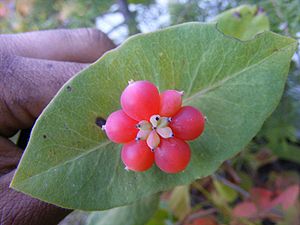Lonicera ciliosa
| Lonicera ciliosa | |
|---|---|

| |
| Scientific classification | |
| Kingdom: | Plantae |
| Clade: | Tracheophytes |
| Clade: | Angiosperms |
| Clade: | Eudicots |
| Clade: | Asterids |
| Order: | Dipsacales |
| Family: | Caprifoliaceae |
| Genus: | Lonicera |
| Species: | L. ciliosa
|
| Binomial name | |
| Lonicera ciliosa | |
Wikimedia Commons has media related to Lonicera ciliosa.
Lonicera ciliosa, the orange honeysuckle or western trumpet honeysuckle is a honeysuckle native to forests of western North America. A deciduous shrub growing to 6 m (20 ft) tall with hollow twigs, the leaves are opposite, oval, 4–10 cm (1.6–3.9 in) long with the last pair on each twig merged to form a disk. The flowers are orange-yellow, 2–4 cm (0.79–1.57 in) long, with five lobes and trumpet shaped; they are produced in whorls above the disk-leaf on the ends of shoots. The fruit is a translucent orange-red berry less than 1 cm (0.39 in) diameter.[1][2]
Edible uses
The fruits are edible either raw or cooked, but are not a common food.[3]
References

